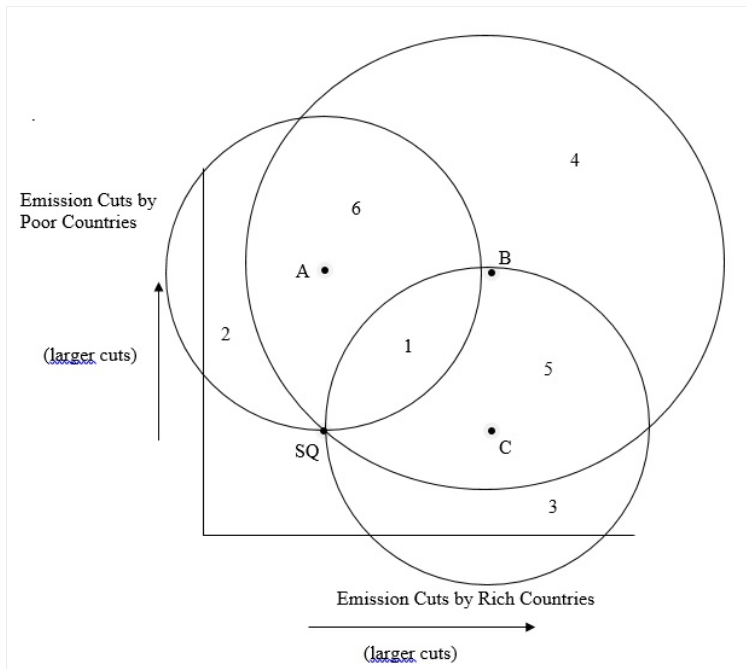Most governments are concerned about climate change. They have thus sought to negotiate an agreement to reduce carbon emissions. These negotiations have been difficult because governments disagree about who should bear the burden of reducing emissions. Suppose governments have the following preferences: Poor countries such as China and India believe that poor countries should not have to make further emissions cuts, while rich countries should make large cuts. The US believes that rich countries should not have to make further cuts, but that poor countries should make large cuts. The European Union (EU) would like both groups of countries to make large cuts. These ideal points are depicted in the two-dimensional space below. “SQ” is the status quo, and represents the emissions cuts that governments have already agreed to in prior climate negotiations. QUESTION: In the figure, the numbers (1 through 6) refer to the regions demarcated by the various indifference curves. 1.Does a win set exist that all of these actors (EU, US, China/India) prefer to the status quo? (Answer yes or no.) 2. If so, where is it? (Enter either the relevant number or NA.) 3.Given your answers, do you expect an agreement that moves policies away from the status quo? (Yes or No)
Most governments are concerned about climate change. They have thus sought to negotiate an agreement to reduce carbon emissions. These negotiations have been difficult because governments disagree about who should bear the burden of reducing emissions. Suppose governments have the following preferences: Poor countries such as China and India believe that poor countries should not have to make further emissions cuts, while rich countries should make large cuts. The US believes that rich countries should not have to make further cuts, but that poor countries should make large cuts. The European Union (EU) would like both groups of countries to make large cuts. These ideal points are depicted in the two-dimensional space below. “SQ” is the status quo, and represents the emissions cuts that governments have already agreed to in prior climate negotiations.
QUESTION:
In the figure, the numbers (1 through 6) refer to the regions demarcated by the various indifference
1.Does a win set exist that all of these actors (EU, US, China/India) prefer to the status quo? (Answer yes or no.)
2. If so, where is it? (Enter either the relevant number or NA.)
3.Given your answers, do you expect an agreement that moves policies away from the status quo? (Yes or No)

Given information
3 sets of the country
Rich country
Poor country
European Union
Rich country prefers larger emission cut by poor country
Poor country prefers larger emission cut by the rich country
European Union prefers to emission cut by both type of countries

Trending now
This is a popular solution!
Step by step
Solved in 2 steps with 1 images









